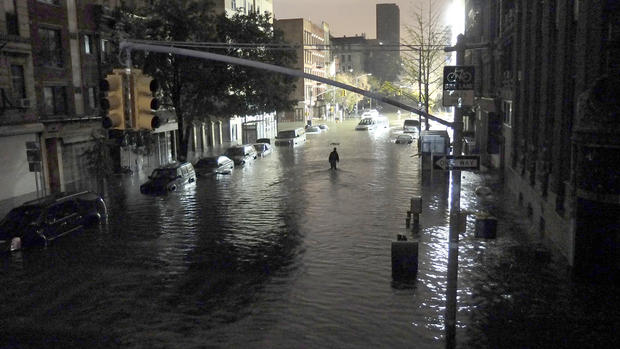Behind the scenes of the NYU hospital evacuation
After the onslaught of superstorm Sandy caused the back-up generator at New York University's medical center to fail, hospital officials say at least 300 patients were successfully evacuated to other area hospitals overnight.
Fifty to 70 ambulances lined up along First Avenue in Kips Bay at around midnight Monday, just a few hours after Sandy made landfall in New Jersey and melded with a cold weather system into a nasty storm that left much of Manhattan in the dark and flooded streets and subway systems.
- Evacuations after major NYC hospital loses backup power
- Dangling crane becomes scary NYC tourist attraction
- NYC faces transit nightmare, outages after Sandy
Power had went down across Manhattan from 39th Street to the financial district, taking the hospital's electricity along with it. Backup generators kept things going, but started to fail at 11 p.m. as water flooded into the basement.
"We had a failure of our primary power, our secondary power, our backup, all the backup systems failed within 30 minutes," Dr. Robert Grossman, NYU Langone Medical Center Dean and CEO, told CBS medical correspondent Dr. Jon LaPook.
LaPook reports that it quickly became a race against time to evacuate 300 patients, including 20 newborns from the neo-natal intensive care unit. By morning, the building's lecture hall was submerged in 12 feet of water.
There were two things that had to be taken care of immediately, LaPook reports: For one, hospital personnel had to make sure that no one was left behind; Second, they needed to figure out who was the sickest and who needed to go down first.
Christine Chin, 31, was in the intensive care unit with complications following a liver transplant. She was taken down 14 flights of stars with a plastic sled that EMTs use and was transferred to Mount Sinai Medical Center.
"At every turn and corner the great thing about it was they would keeping asking me ask me 'are you OK, are you Ok?" she said.
The hospital's largest benefactor and board director, Kenneth Langone, was also reportedly a patient at the hospital late Monday night. The billionaire venture capitalist told the Wall Street Journal he had been at the hospital since Sunday getting treatment for pneumonia and saw water from East River flood onto the FDR Drive an into the medical center.
"It was one of the most moving experiences of my life," he told the newspaper in a telephone interview. He also praised Dean Grossman and hospital officials in an interview to Bloomberg, saying there was nothing more they could have done to prevent the generators from failing.
"We believed we had the machines, we believed the machines would work, and we believed everything we were told about the scope and size of the storm," Langone said, according to Bloomberg. "Do you think they'd have kept me in there if they thought I was going to be unsafe?"
According to the Wall Street Journal, Langone was directly discharged at about 5 in the morning. A phone call to his residence by CBS News was not immediately returned.
In 2008, New York University announced that Langone and his wife had made a $100 million donation to it's medical center, which would be subsequently named in his honor. The New York Times reported back then the school planned on using the money for a new hospital pavilion and a "campus road map" to unify all its buildings.
Goldman Sachs executive Gary D. Cohn, a member of NYU Hospital's Board of Trustees, told Bloomberg TV Tuesday that the generators were not "state-of-the-art" and they are undergoing a $3 billion effort to upgrade its facilities.
Grossman, the dean, told CBS News the blackout is a terrible thing to happen to a hospital, but said it could have been worse.
"It is a bad case, it's hard to imagine a worse case, but the worst case would have been if we lost one patient. That would have been the worst case," he said.
On its website, the Langone Medical center said it is still assessing the full extent of the storm's impact on all its patient care, research and education facilities.
